Comprehensive Analysis: Contemporary Management Issues at Waitrose
VerifiedAdded on 2020/06/04
|9
|2843
|338
Report
AI Summary
This report delves into the contemporary management issues at Waitrose, a UK-based retail company. It begins by identifying dynamic forces like technological advancements, economic shifts, market needs, media influence, environmental factors, political regulations, ideological changes, sociological trends, moral ethics, and regulatory bodies, and how they impact the business. The report then evaluates the interconnectedness of these forces in terms of effective strategic decision-making, highlighting how media and ethics, sociological and weather conditions, and technological and market forces influence each other. Finally, the report discusses decision-making tools, such as cost-benefit analysis, decision matrices, and decision trees, that Waitrose employs to address contemporary drivers of change, including international dimensions, cultural and social diversity, and various social issues. The analysis provides insights into how Waitrose navigates its operational environment and makes strategic choices.
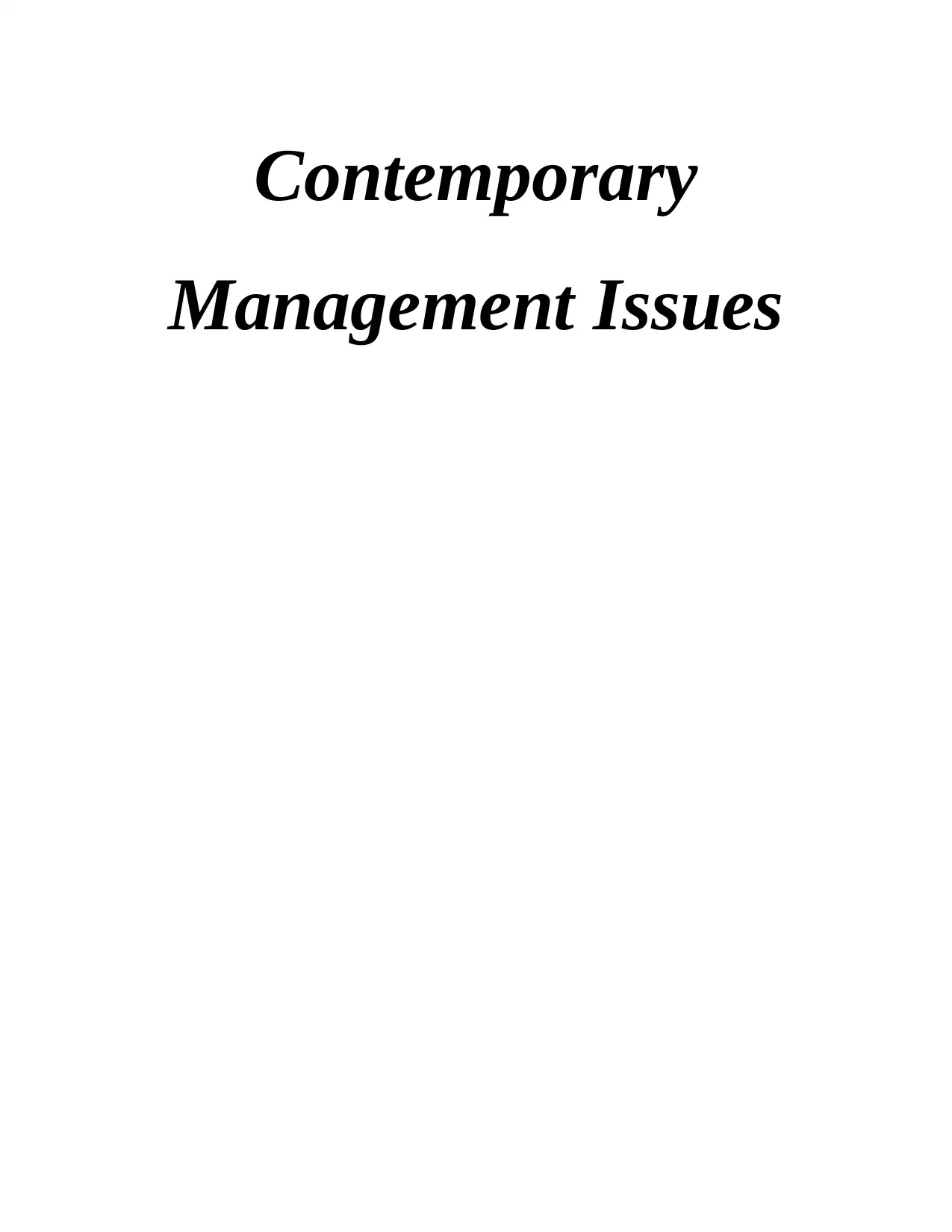
Contemporary
Management Issues
Management Issues
Paraphrase This Document
Need a fresh take? Get an instant paraphrase of this document with our AI Paraphraser
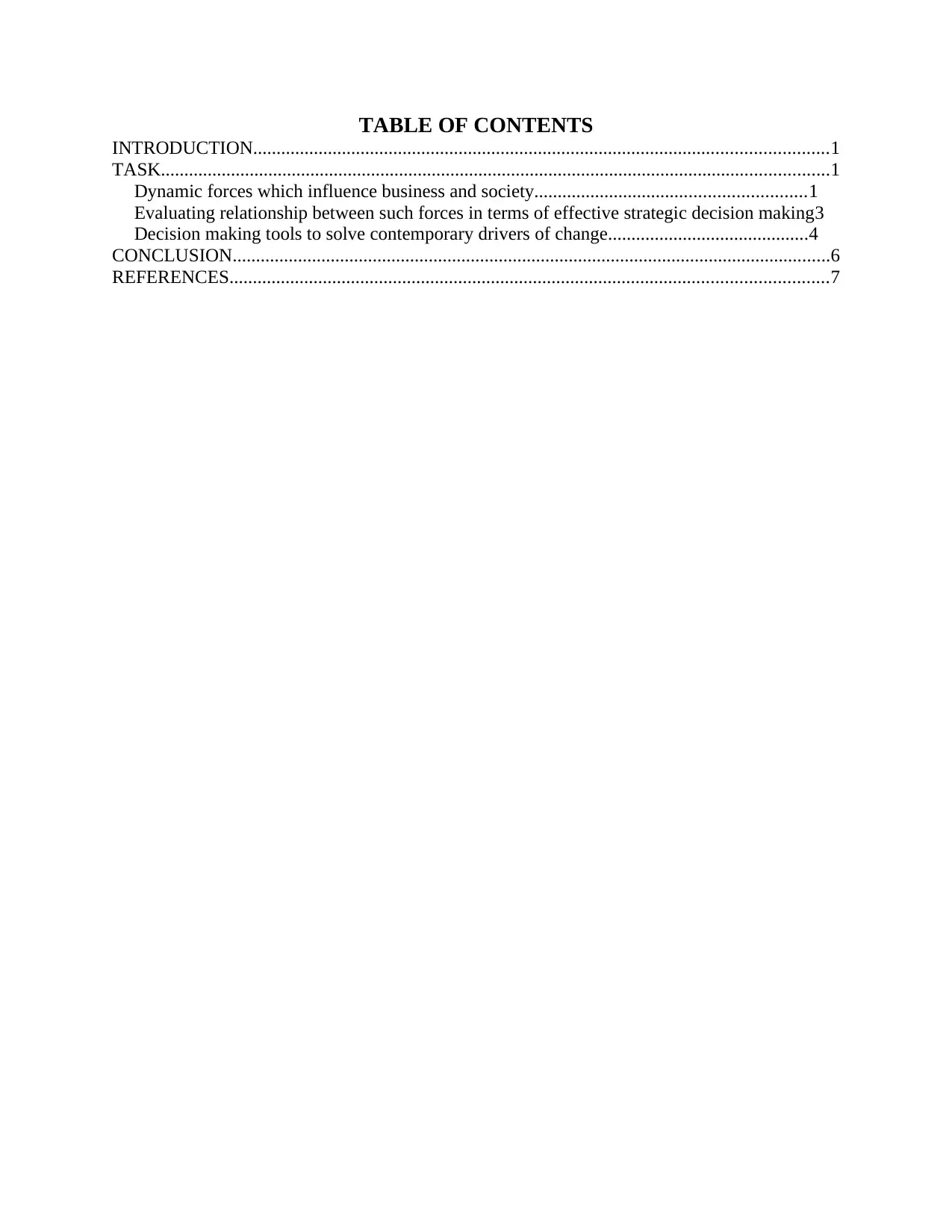
TABLE OF CONTENTS
INTRODUCTION...........................................................................................................................1
TASK...............................................................................................................................................1
Dynamic forces which influence business and society..........................................................1
Evaluating relationship between such forces in terms of effective strategic decision making3
Decision making tools to solve contemporary drivers of change...........................................4
CONCLUSION................................................................................................................................6
REFERENCES................................................................................................................................7
INTRODUCTION...........................................................................................................................1
TASK...............................................................................................................................................1
Dynamic forces which influence business and society..........................................................1
Evaluating relationship between such forces in terms of effective strategic decision making3
Decision making tools to solve contemporary drivers of change...........................................4
CONCLUSION................................................................................................................................6
REFERENCES................................................................................................................................7
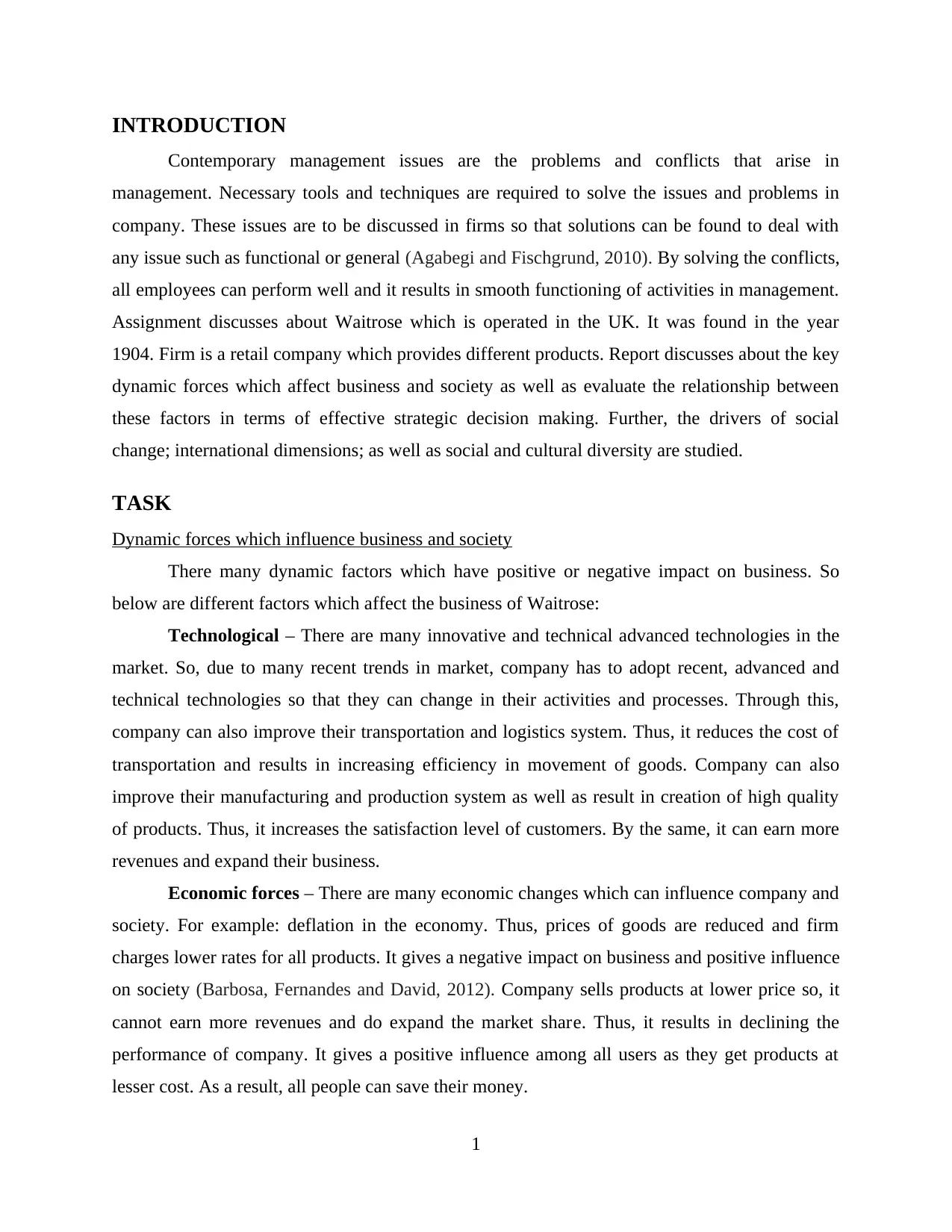
INTRODUCTION
Contemporary management issues are the problems and conflicts that arise in
management. Necessary tools and techniques are required to solve the issues and problems in
company. These issues are to be discussed in firms so that solutions can be found to deal with
any issue such as functional or general (Agabegi and Fischgrund, 2010). By solving the conflicts,
all employees can perform well and it results in smooth functioning of activities in management.
Assignment discusses about Waitrose which is operated in the UK. It was found in the year
1904. Firm is a retail company which provides different products. Report discusses about the key
dynamic forces which affect business and society as well as evaluate the relationship between
these factors in terms of effective strategic decision making. Further, the drivers of social
change; international dimensions; as well as social and cultural diversity are studied.
TASK
Dynamic forces which influence business and society
There many dynamic factors which have positive or negative impact on business. So
below are different factors which affect the business of Waitrose:
Technological – There are many innovative and technical advanced technologies in the
market. So, due to many recent trends in market, company has to adopt recent, advanced and
technical technologies so that they can change in their activities and processes. Through this,
company can also improve their transportation and logistics system. Thus, it reduces the cost of
transportation and results in increasing efficiency in movement of goods. Company can also
improve their manufacturing and production system as well as result in creation of high quality
of products. Thus, it increases the satisfaction level of customers. By the same, it can earn more
revenues and expand their business.
Economic forces – There are many economic changes which can influence company and
society. For example: deflation in the economy. Thus, prices of goods are reduced and firm
charges lower rates for all products. It gives a negative impact on business and positive influence
on society (Barbosa, Fernandes and David, 2012). Company sells products at lower price so, it
cannot earn more revenues and do expand the market share. Thus, it results in declining the
performance of company. It gives a positive influence among all users as they get products at
lesser cost. As a result, all people can save their money.
1
Contemporary management issues are the problems and conflicts that arise in
management. Necessary tools and techniques are required to solve the issues and problems in
company. These issues are to be discussed in firms so that solutions can be found to deal with
any issue such as functional or general (Agabegi and Fischgrund, 2010). By solving the conflicts,
all employees can perform well and it results in smooth functioning of activities in management.
Assignment discusses about Waitrose which is operated in the UK. It was found in the year
1904. Firm is a retail company which provides different products. Report discusses about the key
dynamic forces which affect business and society as well as evaluate the relationship between
these factors in terms of effective strategic decision making. Further, the drivers of social
change; international dimensions; as well as social and cultural diversity are studied.
TASK
Dynamic forces which influence business and society
There many dynamic factors which have positive or negative impact on business. So
below are different factors which affect the business of Waitrose:
Technological – There are many innovative and technical advanced technologies in the
market. So, due to many recent trends in market, company has to adopt recent, advanced and
technical technologies so that they can change in their activities and processes. Through this,
company can also improve their transportation and logistics system. Thus, it reduces the cost of
transportation and results in increasing efficiency in movement of goods. Company can also
improve their manufacturing and production system as well as result in creation of high quality
of products. Thus, it increases the satisfaction level of customers. By the same, it can earn more
revenues and expand their business.
Economic forces – There are many economic changes which can influence company and
society. For example: deflation in the economy. Thus, prices of goods are reduced and firm
charges lower rates for all products. It gives a negative impact on business and positive influence
on society (Barbosa, Fernandes and David, 2012). Company sells products at lower price so, it
cannot earn more revenues and do expand the market share. Thus, it results in declining the
performance of company. It gives a positive influence among all users as they get products at
lesser cost. As a result, all people can save their money.
1
⊘ This is a preview!⊘
Do you want full access?
Subscribe today to unlock all pages.

Trusted by 1+ million students worldwide
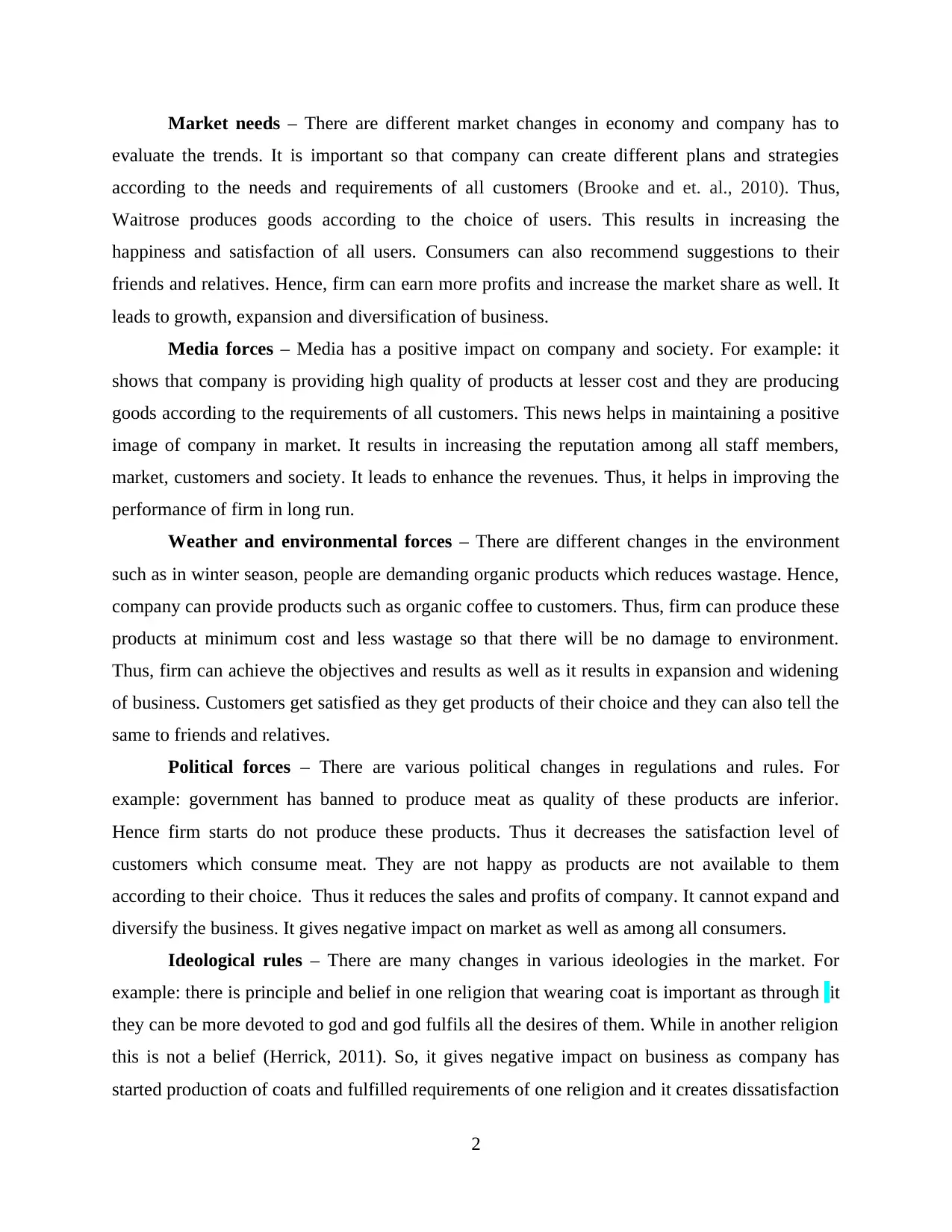
Market needs – There are different market changes in economy and company has to
evaluate the trends. It is important so that company can create different plans and strategies
according to the needs and requirements of all customers (Brooke and et. al., 2010). Thus,
Waitrose produces goods according to the choice of users. This results in increasing the
happiness and satisfaction of all users. Consumers can also recommend suggestions to their
friends and relatives. Hence, firm can earn more profits and increase the market share as well. It
leads to growth, expansion and diversification of business.
Media forces – Media has a positive impact on company and society. For example: it
shows that company is providing high quality of products at lesser cost and they are producing
goods according to the requirements of all customers. This news helps in maintaining a positive
image of company in market. It results in increasing the reputation among all staff members,
market, customers and society. It leads to enhance the revenues. Thus, it helps in improving the
performance of firm in long run.
Weather and environmental forces – There are different changes in the environment
such as in winter season, people are demanding organic products which reduces wastage. Hence,
company can provide products such as organic coffee to customers. Thus, firm can produce these
products at minimum cost and less wastage so that there will be no damage to environment.
Thus, firm can achieve the objectives and results as well as it results in expansion and widening
of business. Customers get satisfied as they get products of their choice and they can also tell the
same to friends and relatives.
Political forces – There are various political changes in regulations and rules. For
example: government has banned to produce meat as quality of these products are inferior.
Hence firm starts do not produce these products. Thus it decreases the satisfaction level of
customers which consume meat. They are not happy as products are not available to them
according to their choice. Thus it reduces the sales and profits of company. It cannot expand and
diversify the business. It gives negative impact on market as well as among all consumers.
Ideological rules – There are many changes in various ideologies in the market. For
example: there is principle and belief in one religion that wearing coat is important as through it
they can be more devoted to god and god fulfils all the desires of them. While in another religion
this is not a belief (Herrick, 2011). So, it gives negative impact on business as company has
started production of coats and fulfilled requirements of one religion and it creates dissatisfaction
2
evaluate the trends. It is important so that company can create different plans and strategies
according to the needs and requirements of all customers (Brooke and et. al., 2010). Thus,
Waitrose produces goods according to the choice of users. This results in increasing the
happiness and satisfaction of all users. Consumers can also recommend suggestions to their
friends and relatives. Hence, firm can earn more profits and increase the market share as well. It
leads to growth, expansion and diversification of business.
Media forces – Media has a positive impact on company and society. For example: it
shows that company is providing high quality of products at lesser cost and they are producing
goods according to the requirements of all customers. This news helps in maintaining a positive
image of company in market. It results in increasing the reputation among all staff members,
market, customers and society. It leads to enhance the revenues. Thus, it helps in improving the
performance of firm in long run.
Weather and environmental forces – There are different changes in the environment
such as in winter season, people are demanding organic products which reduces wastage. Hence,
company can provide products such as organic coffee to customers. Thus, firm can produce these
products at minimum cost and less wastage so that there will be no damage to environment.
Thus, firm can achieve the objectives and results as well as it results in expansion and widening
of business. Customers get satisfied as they get products of their choice and they can also tell the
same to friends and relatives.
Political forces – There are various political changes in regulations and rules. For
example: government has banned to produce meat as quality of these products are inferior.
Hence firm starts do not produce these products. Thus it decreases the satisfaction level of
customers which consume meat. They are not happy as products are not available to them
according to their choice. Thus it reduces the sales and profits of company. It cannot expand and
diversify the business. It gives negative impact on market as well as among all consumers.
Ideological rules – There are many changes in various ideologies in the market. For
example: there is principle and belief in one religion that wearing coat is important as through it
they can be more devoted to god and god fulfils all the desires of them. While in another religion
this is not a belief (Herrick, 2011). So, it gives negative impact on business as company has
started production of coats and fulfilled requirements of one religion and it creates dissatisfaction
2
Paraphrase This Document
Need a fresh take? Get an instant paraphrase of this document with our AI Paraphraser
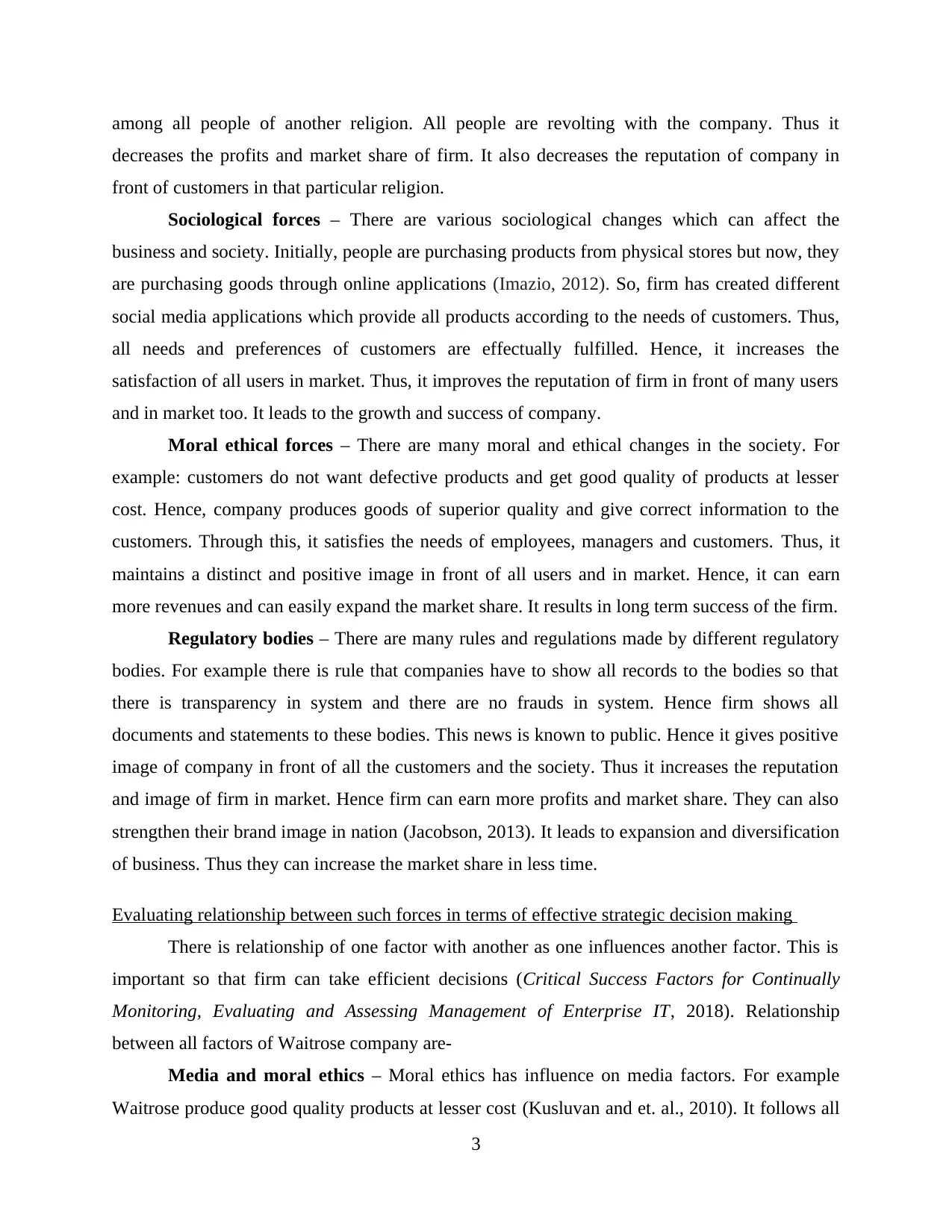
among all people of another religion. All people are revolting with the company. Thus it
decreases the profits and market share of firm. It also decreases the reputation of company in
front of customers in that particular religion.
Sociological forces – There are various sociological changes which can affect the
business and society. Initially, people are purchasing products from physical stores but now, they
are purchasing goods through online applications (Imazio, 2012). So, firm has created different
social media applications which provide all products according to the needs of customers. Thus,
all needs and preferences of customers are effectually fulfilled. Hence, it increases the
satisfaction of all users in market. Thus, it improves the reputation of firm in front of many users
and in market too. It leads to the growth and success of company.
Moral ethical forces – There are many moral and ethical changes in the society. For
example: customers do not want defective products and get good quality of products at lesser
cost. Hence, company produces goods of superior quality and give correct information to the
customers. Through this, it satisfies the needs of employees, managers and customers. Thus, it
maintains a distinct and positive image in front of all users and in market. Hence, it can earn
more revenues and can easily expand the market share. It results in long term success of the firm.
Regulatory bodies – There are many rules and regulations made by different regulatory
bodies. For example there is rule that companies have to show all records to the bodies so that
there is transparency in system and there are no frauds in system. Hence firm shows all
documents and statements to these bodies. This news is known to public. Hence it gives positive
image of company in front of all the customers and the society. Thus it increases the reputation
and image of firm in market. Hence firm can earn more profits and market share. They can also
strengthen their brand image in nation (Jacobson, 2013). It leads to expansion and diversification
of business. Thus they can increase the market share in less time.
Evaluating relationship between such forces in terms of effective strategic decision making
There is relationship of one factor with another as one influences another factor. This is
important so that firm can take efficient decisions (Critical Success Factors for Continually
Monitoring, Evaluating and Assessing Management of Enterprise IT, 2018). Relationship
between all factors of Waitrose company are-
Media and moral ethics – Moral ethics has influence on media factors. For example
Waitrose produce good quality products at lesser cost (Kusluvan and et. al., 2010). It follows all
3
decreases the profits and market share of firm. It also decreases the reputation of company in
front of customers in that particular religion.
Sociological forces – There are various sociological changes which can affect the
business and society. Initially, people are purchasing products from physical stores but now, they
are purchasing goods through online applications (Imazio, 2012). So, firm has created different
social media applications which provide all products according to the needs of customers. Thus,
all needs and preferences of customers are effectually fulfilled. Hence, it increases the
satisfaction of all users in market. Thus, it improves the reputation of firm in front of many users
and in market too. It leads to the growth and success of company.
Moral ethical forces – There are many moral and ethical changes in the society. For
example: customers do not want defective products and get good quality of products at lesser
cost. Hence, company produces goods of superior quality and give correct information to the
customers. Through this, it satisfies the needs of employees, managers and customers. Thus, it
maintains a distinct and positive image in front of all users and in market. Hence, it can earn
more revenues and can easily expand the market share. It results in long term success of the firm.
Regulatory bodies – There are many rules and regulations made by different regulatory
bodies. For example there is rule that companies have to show all records to the bodies so that
there is transparency in system and there are no frauds in system. Hence firm shows all
documents and statements to these bodies. This news is known to public. Hence it gives positive
image of company in front of all the customers and the society. Thus it increases the reputation
and image of firm in market. Hence firm can earn more profits and market share. They can also
strengthen their brand image in nation (Jacobson, 2013). It leads to expansion and diversification
of business. Thus they can increase the market share in less time.
Evaluating relationship between such forces in terms of effective strategic decision making
There is relationship of one factor with another as one influences another factor. This is
important so that firm can take efficient decisions (Critical Success Factors for Continually
Monitoring, Evaluating and Assessing Management of Enterprise IT, 2018). Relationship
between all factors of Waitrose company are-
Media and moral ethics – Moral ethics has influence on media factors. For example
Waitrose produce good quality products at lesser cost (Kusluvan and et. al., 2010). It follows all
3
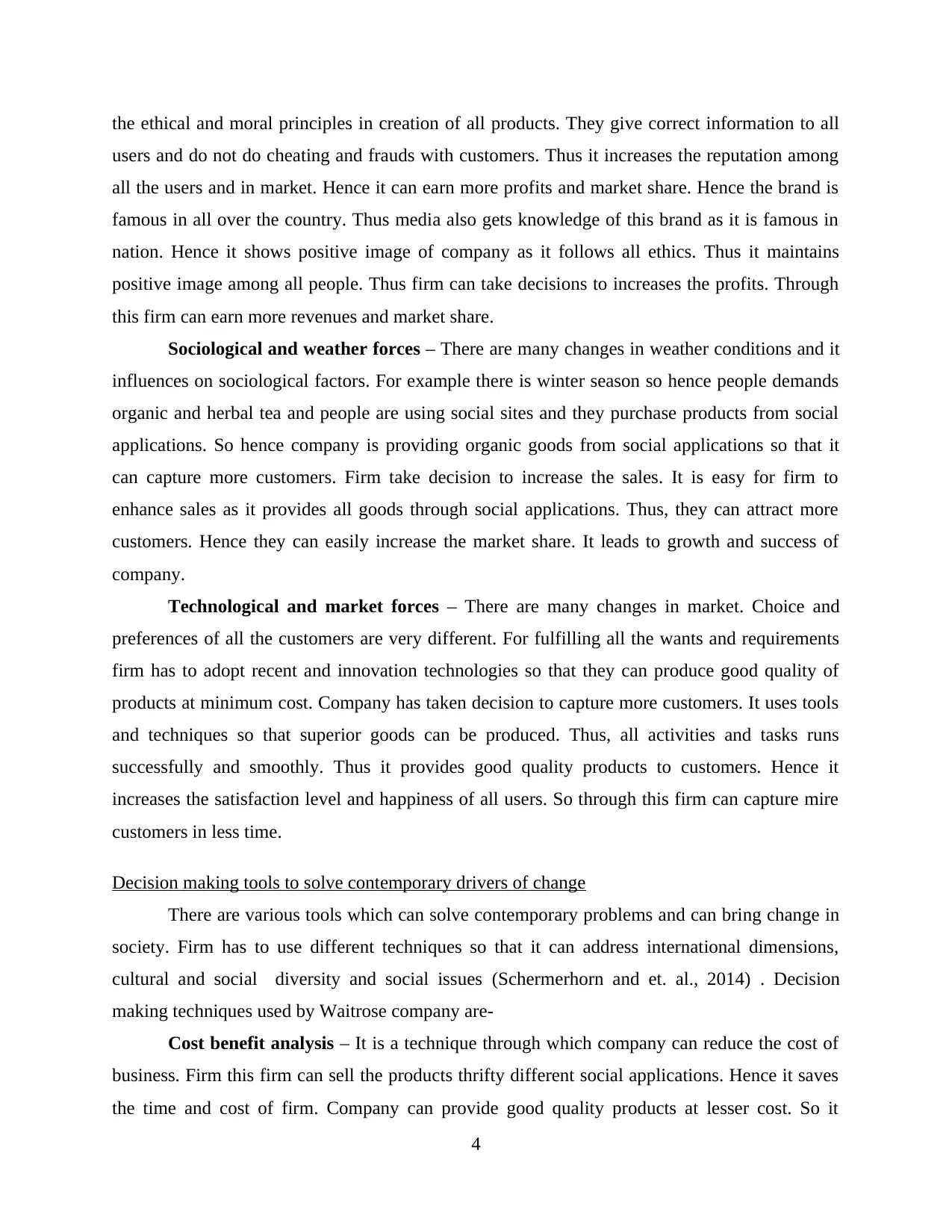
the ethical and moral principles in creation of all products. They give correct information to all
users and do not do cheating and frauds with customers. Thus it increases the reputation among
all the users and in market. Hence it can earn more profits and market share. Hence the brand is
famous in all over the country. Thus media also gets knowledge of this brand as it is famous in
nation. Hence it shows positive image of company as it follows all ethics. Thus it maintains
positive image among all people. Thus firm can take decisions to increases the profits. Through
this firm can earn more revenues and market share.
Sociological and weather forces – There are many changes in weather conditions and it
influences on sociological factors. For example there is winter season so hence people demands
organic and herbal tea and people are using social sites and they purchase products from social
applications. So hence company is providing organic goods from social applications so that it
can capture more customers. Firm take decision to increase the sales. It is easy for firm to
enhance sales as it provides all goods through social applications. Thus, they can attract more
customers. Hence they can easily increase the market share. It leads to growth and success of
company.
Technological and market forces – There are many changes in market. Choice and
preferences of all the customers are very different. For fulfilling all the wants and requirements
firm has to adopt recent and innovation technologies so that they can produce good quality of
products at minimum cost. Company has taken decision to capture more customers. It uses tools
and techniques so that superior goods can be produced. Thus, all activities and tasks runs
successfully and smoothly. Thus it provides good quality products to customers. Hence it
increases the satisfaction level and happiness of all users. So through this firm can capture mire
customers in less time.
Decision making tools to solve contemporary drivers of change
There are various tools which can solve contemporary problems and can bring change in
society. Firm has to use different techniques so that it can address international dimensions,
cultural and social diversity and social issues (Schermerhorn and et. al., 2014) . Decision
making techniques used by Waitrose company are-
Cost benefit analysis – It is a technique through which company can reduce the cost of
business. Firm this firm can sell the products thrifty different social applications. Hence it saves
the time and cost of firm. Company can provide good quality products at lesser cost. So it
4
users and do not do cheating and frauds with customers. Thus it increases the reputation among
all the users and in market. Hence it can earn more profits and market share. Hence the brand is
famous in all over the country. Thus media also gets knowledge of this brand as it is famous in
nation. Hence it shows positive image of company as it follows all ethics. Thus it maintains
positive image among all people. Thus firm can take decisions to increases the profits. Through
this firm can earn more revenues and market share.
Sociological and weather forces – There are many changes in weather conditions and it
influences on sociological factors. For example there is winter season so hence people demands
organic and herbal tea and people are using social sites and they purchase products from social
applications. So hence company is providing organic goods from social applications so that it
can capture more customers. Firm take decision to increase the sales. It is easy for firm to
enhance sales as it provides all goods through social applications. Thus, they can attract more
customers. Hence they can easily increase the market share. It leads to growth and success of
company.
Technological and market forces – There are many changes in market. Choice and
preferences of all the customers are very different. For fulfilling all the wants and requirements
firm has to adopt recent and innovation technologies so that they can produce good quality of
products at minimum cost. Company has taken decision to capture more customers. It uses tools
and techniques so that superior goods can be produced. Thus, all activities and tasks runs
successfully and smoothly. Thus it provides good quality products to customers. Hence it
increases the satisfaction level and happiness of all users. So through this firm can capture mire
customers in less time.
Decision making tools to solve contemporary drivers of change
There are various tools which can solve contemporary problems and can bring change in
society. Firm has to use different techniques so that it can address international dimensions,
cultural and social diversity and social issues (Schermerhorn and et. al., 2014) . Decision
making techniques used by Waitrose company are-
Cost benefit analysis – It is a technique through which company can reduce the cost of
business. Firm this firm can sell the products thrifty different social applications. Hence it saves
the time and cost of firm. Company can provide good quality products at lesser cost. So it
4
⊘ This is a preview!⊘
Do you want full access?
Subscribe today to unlock all pages.

Trusted by 1+ million students worldwide
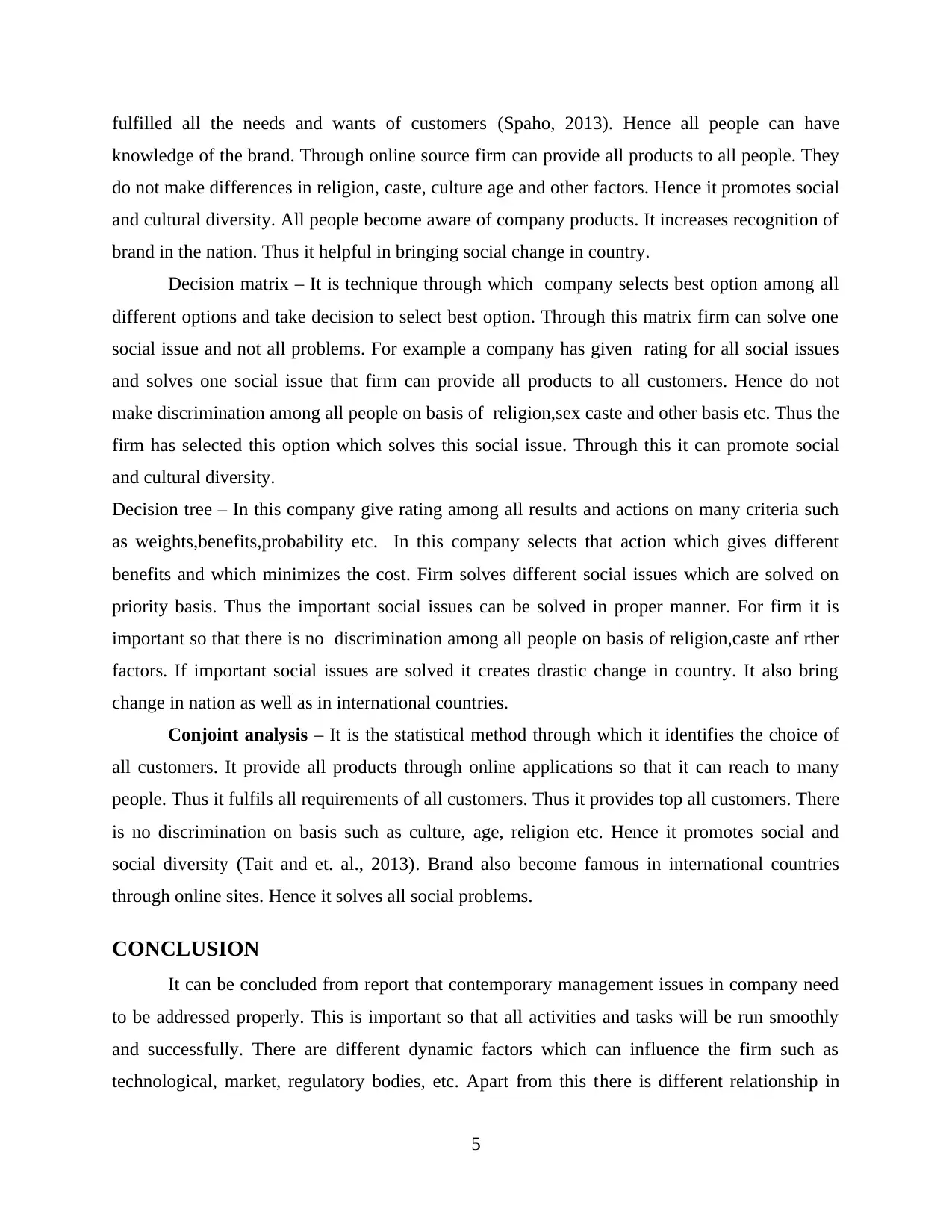
fulfilled all the needs and wants of customers (Spaho, 2013). Hence all people can have
knowledge of the brand. Through online source firm can provide all products to all people. They
do not make differences in religion, caste, culture age and other factors. Hence it promotes social
and cultural diversity. All people become aware of company products. It increases recognition of
brand in the nation. Thus it helpful in bringing social change in country.
Decision matrix – It is technique through which company selects best option among all
different options and take decision to select best option. Through this matrix firm can solve one
social issue and not all problems. For example a company has given rating for all social issues
and solves one social issue that firm can provide all products to all customers. Hence do not
make discrimination among all people on basis of religion,sex caste and other basis etc. Thus the
firm has selected this option which solves this social issue. Through this it can promote social
and cultural diversity.
Decision tree – In this company give rating among all results and actions on many criteria such
as weights,benefits,probability etc. In this company selects that action which gives different
benefits and which minimizes the cost. Firm solves different social issues which are solved on
priority basis. Thus the important social issues can be solved in proper manner. For firm it is
important so that there is no discrimination among all people on basis of religion,caste anf rther
factors. If important social issues are solved it creates drastic change in country. It also bring
change in nation as well as in international countries.
Conjoint analysis – It is the statistical method through which it identifies the choice of
all customers. It provide all products through online applications so that it can reach to many
people. Thus it fulfils all requirements of all customers. Thus it provides top all customers. There
is no discrimination on basis such as culture, age, religion etc. Hence it promotes social and
social diversity (Tait and et. al., 2013). Brand also become famous in international countries
through online sites. Hence it solves all social problems.
CONCLUSION
It can be concluded from report that contemporary management issues in company need
to be addressed properly. This is important so that all activities and tasks will be run smoothly
and successfully. There are different dynamic factors which can influence the firm such as
technological, market, regulatory bodies, etc. Apart from this there is different relationship in
5
knowledge of the brand. Through online source firm can provide all products to all people. They
do not make differences in religion, caste, culture age and other factors. Hence it promotes social
and cultural diversity. All people become aware of company products. It increases recognition of
brand in the nation. Thus it helpful in bringing social change in country.
Decision matrix – It is technique through which company selects best option among all
different options and take decision to select best option. Through this matrix firm can solve one
social issue and not all problems. For example a company has given rating for all social issues
and solves one social issue that firm can provide all products to all customers. Hence do not
make discrimination among all people on basis of religion,sex caste and other basis etc. Thus the
firm has selected this option which solves this social issue. Through this it can promote social
and cultural diversity.
Decision tree – In this company give rating among all results and actions on many criteria such
as weights,benefits,probability etc. In this company selects that action which gives different
benefits and which minimizes the cost. Firm solves different social issues which are solved on
priority basis. Thus the important social issues can be solved in proper manner. For firm it is
important so that there is no discrimination among all people on basis of religion,caste anf rther
factors. If important social issues are solved it creates drastic change in country. It also bring
change in nation as well as in international countries.
Conjoint analysis – It is the statistical method through which it identifies the choice of
all customers. It provide all products through online applications so that it can reach to many
people. Thus it fulfils all requirements of all customers. Thus it provides top all customers. There
is no discrimination on basis such as culture, age, religion etc. Hence it promotes social and
social diversity (Tait and et. al., 2013). Brand also become famous in international countries
through online sites. Hence it solves all social problems.
CONCLUSION
It can be concluded from report that contemporary management issues in company need
to be addressed properly. This is important so that all activities and tasks will be run smoothly
and successfully. There are different dynamic factors which can influence the firm such as
technological, market, regulatory bodies, etc. Apart from this there is different relationship in
5
Paraphrase This Document
Need a fresh take? Get an instant paraphrase of this document with our AI Paraphraser
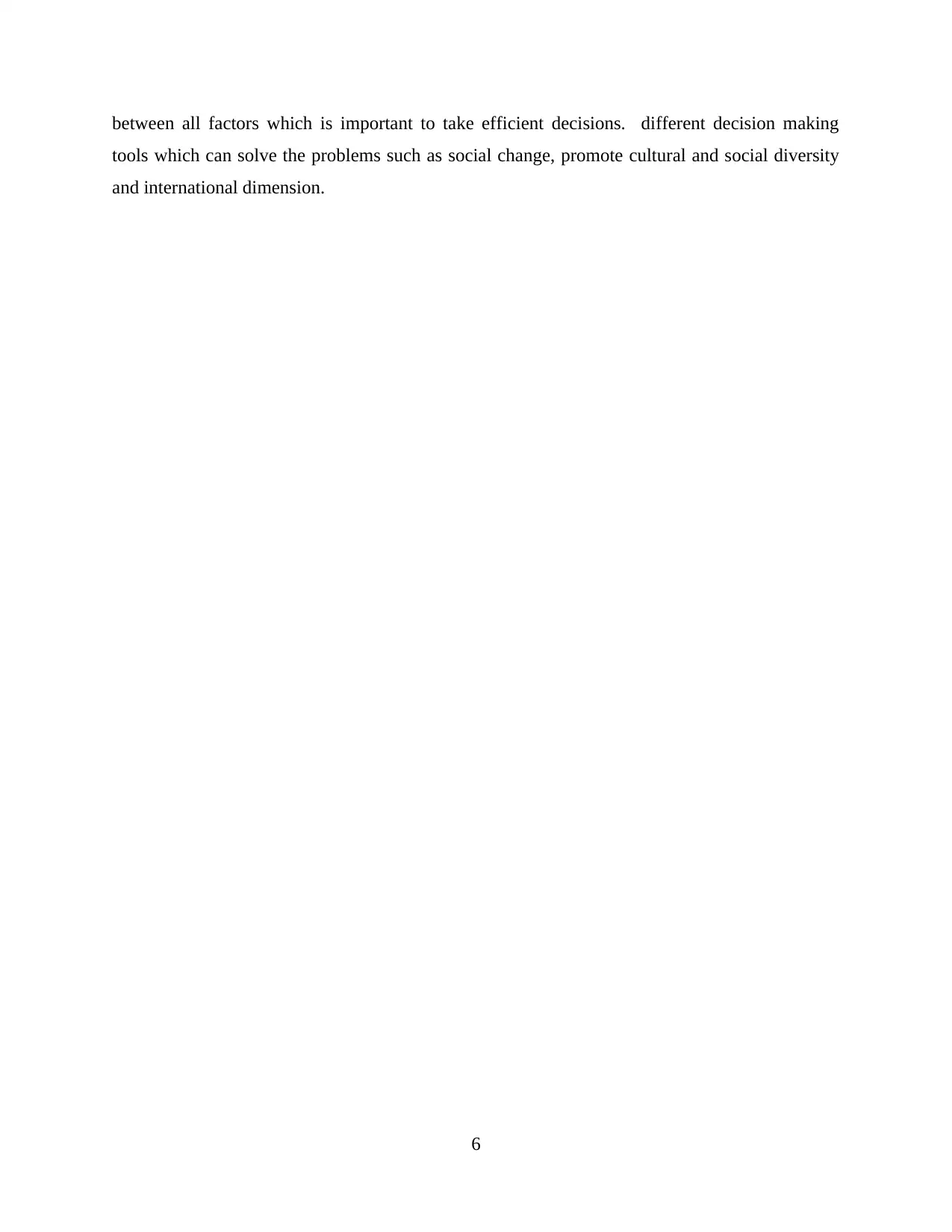
between all factors which is important to take efficient decisions. different decision making
tools which can solve the problems such as social change, promote cultural and social diversity
and international dimension.
6
tools which can solve the problems such as social change, promote cultural and social diversity
and international dimension.
6
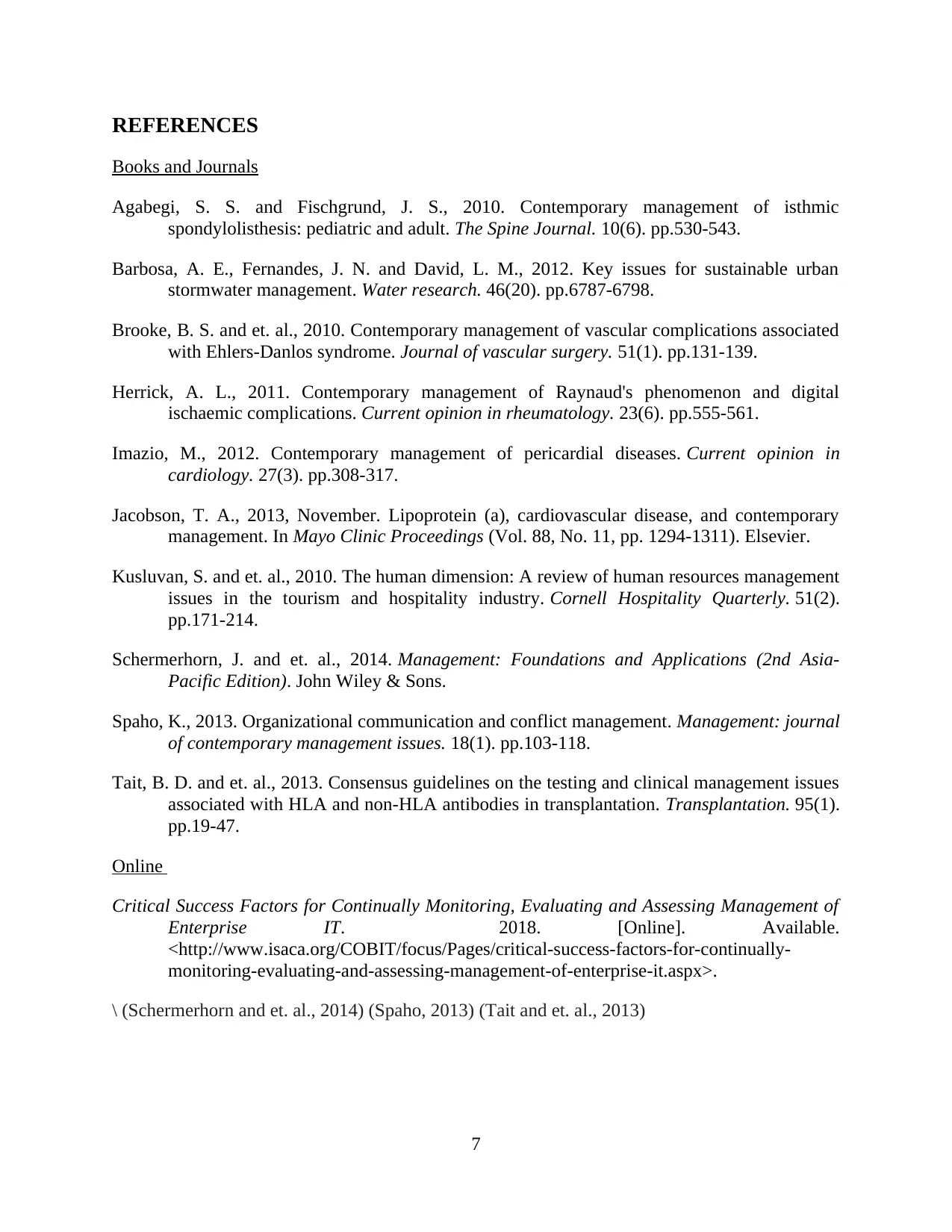
REFERENCES
Books and Journals
Agabegi, S. S. and Fischgrund, J. S., 2010. Contemporary management of isthmic
spondylolisthesis: pediatric and adult. The Spine Journal. 10(6). pp.530-543.
Barbosa, A. E., Fernandes, J. N. and David, L. M., 2012. Key issues for sustainable urban
stormwater management. Water research. 46(20). pp.6787-6798.
Brooke, B. S. and et. al., 2010. Contemporary management of vascular complications associated
with Ehlers-Danlos syndrome. Journal of vascular surgery. 51(1). pp.131-139.
Herrick, A. L., 2011. Contemporary management of Raynaud's phenomenon and digital
ischaemic complications. Current opinion in rheumatology. 23(6). pp.555-561.
Imazio, M., 2012. Contemporary management of pericardial diseases. Current opinion in
cardiology. 27(3). pp.308-317.
Jacobson, T. A., 2013, November. Lipoprotein (a), cardiovascular disease, and contemporary
management. In Mayo Clinic Proceedings (Vol. 88, No. 11, pp. 1294-1311). Elsevier.
Kusluvan, S. and et. al., 2010. The human dimension: A review of human resources management
issues in the tourism and hospitality industry. Cornell Hospitality Quarterly. 51(2).
pp.171-214.
Schermerhorn, J. and et. al., 2014. Management: Foundations and Applications (2nd Asia-
Pacific Edition). John Wiley & Sons.
Spaho, K., 2013. Organizational communication and conflict management. Management: journal
of contemporary management issues. 18(1). pp.103-118.
Tait, B. D. and et. al., 2013. Consensus guidelines on the testing and clinical management issues
associated with HLA and non-HLA antibodies in transplantation. Transplantation. 95(1).
pp.19-47.
Online
Critical Success Factors for Continually Monitoring, Evaluating and Assessing Management of
Enterprise IT. 2018. [Online]. Available.
<http://www.isaca.org/COBIT/focus/Pages/critical-success-factors-for-continually-
monitoring-evaluating-and-assessing-management-of-enterprise-it.aspx>.
\ (Schermerhorn and et. al., 2014) (Spaho, 2013) (Tait and et. al., 2013)
7
Books and Journals
Agabegi, S. S. and Fischgrund, J. S., 2010. Contemporary management of isthmic
spondylolisthesis: pediatric and adult. The Spine Journal. 10(6). pp.530-543.
Barbosa, A. E., Fernandes, J. N. and David, L. M., 2012. Key issues for sustainable urban
stormwater management. Water research. 46(20). pp.6787-6798.
Brooke, B. S. and et. al., 2010. Contemporary management of vascular complications associated
with Ehlers-Danlos syndrome. Journal of vascular surgery. 51(1). pp.131-139.
Herrick, A. L., 2011. Contemporary management of Raynaud's phenomenon and digital
ischaemic complications. Current opinion in rheumatology. 23(6). pp.555-561.
Imazio, M., 2012. Contemporary management of pericardial diseases. Current opinion in
cardiology. 27(3). pp.308-317.
Jacobson, T. A., 2013, November. Lipoprotein (a), cardiovascular disease, and contemporary
management. In Mayo Clinic Proceedings (Vol. 88, No. 11, pp. 1294-1311). Elsevier.
Kusluvan, S. and et. al., 2010. The human dimension: A review of human resources management
issues in the tourism and hospitality industry. Cornell Hospitality Quarterly. 51(2).
pp.171-214.
Schermerhorn, J. and et. al., 2014. Management: Foundations and Applications (2nd Asia-
Pacific Edition). John Wiley & Sons.
Spaho, K., 2013. Organizational communication and conflict management. Management: journal
of contemporary management issues. 18(1). pp.103-118.
Tait, B. D. and et. al., 2013. Consensus guidelines on the testing and clinical management issues
associated with HLA and non-HLA antibodies in transplantation. Transplantation. 95(1).
pp.19-47.
Online
Critical Success Factors for Continually Monitoring, Evaluating and Assessing Management of
Enterprise IT. 2018. [Online]. Available.
<http://www.isaca.org/COBIT/focus/Pages/critical-success-factors-for-continually-
monitoring-evaluating-and-assessing-management-of-enterprise-it.aspx>.
\ (Schermerhorn and et. al., 2014) (Spaho, 2013) (Tait and et. al., 2013)
7
⊘ This is a preview!⊘
Do you want full access?
Subscribe today to unlock all pages.

Trusted by 1+ million students worldwide
1 out of 9
Related Documents
Your All-in-One AI-Powered Toolkit for Academic Success.
+13062052269
info@desklib.com
Available 24*7 on WhatsApp / Email
![[object Object]](/_next/static/media/star-bottom.7253800d.svg)
Unlock your academic potential
Copyright © 2020–2025 A2Z Services. All Rights Reserved. Developed and managed by ZUCOL.





